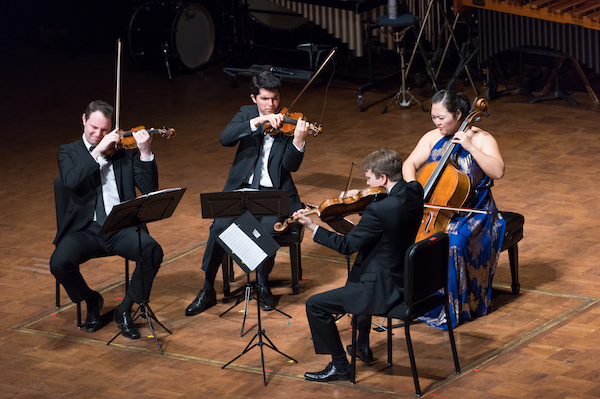Calidore Quartet makes a triumphant return to Kennedy Center

The Calidore String Quartet performed at the Kennedy Center Wednesday night.
The Calidore String Quartet, since their remarkable Kennedy Center debut in 2018, has laid down a track record of sterling performances. The group made a return to the Fortas Chamber Music Concerts series Wednesday night, in the Kennedy Center Terrace Theater. The only regret was that the program did not include Haydn, always a highlight of their previous concerts.
The first half of this concert was planned for their last scheduled appearance, in 2020, canceled by the pandemic. It opened with Beethoven’s String Quartet No. 16, the last of the late quartets featured on the first volume of their new complete Beethoven recording, released earlier this month. This performance showcased their exceptional ensemble cohesion, a careful melding of sound that avoids all harshness.
Violist Jeremy Berry and second violinist Ryan Meehan immediately established the sense of their parts’ strength and independence, trading contrapuntal motifs in the first movement. The group left no detail uncared for, including the careful styling of their mysterious unison tone when all four instruments came together. The fleet and deft second movement played amiably with contrasts of loud and soft, without going too far in either direction.
The high point was the rarefied lushness of the sonorous slow movement, with intonation and blend helped by a minimization of vibrato. This performance gave life to Beethoven’s description of the movement, in the unrelated key of D-flat major, as a “sweet song of rest and peace.” Although the intonation of first violinist Jeffrey Myers occasionally strayed off target, mostly in the top range, his singing line in the final variation was impeccably warm.
Ultimately the crux of this piece lies in the Finale. Beethoven poses a musical question, written in the manuscript as “Must it be?,” to which he responds, with the faster main theme of the movement, “It must be!” Some interpretations emphasize the seriousness of this concept, in what was the last major work Beethoven completed before his death.
Rather than any rumination about mortality, however, the music and words of the response come from a comic canon Beethoven composed in 1826, informing a patron that he must take out his wallet and pay if he wanted to have a performance of one of Beethoven’s string quartets in his house. The four musicians played the Finale with that waggish sense of fun and mock severity, especially the jaunty countermelody in the fast section, reminiscent of a folks song.
The Beethoven paired beautifully with the new work inspired by it, Anna Clyne’s Breathing Statues, co-commissioned by the Kennedy Center. Drawing the title from Rainer Maria Rilke’s poem “To Music,” Clyne centered the work on the sensation of musicians breathing together between phrases. The question and answer from the just-heard Beethoven stood out clearly, as Clyne smeared the themes with glissandi and other effects, but it was just as fun to recognize the daunting theme of the “Grosse Fuge” and other tunes and ideas from the late quartets dotted throughout this substantial piece.
As if in tribute to the individual beauty of each musician’s playing, Clyne structured the piece around a modally charged solo theme, which appeared one by one in each instrument around the quartet. Once cellist Estelle Choi and finally Meehan got the theme, Clyne seemed to prolong the piece unnecessarily, searching for an ending, but overall her score is worthy of many more performances.
Washington, D.C. native George Walker’s Lyric for Strings played to the same strengths as the Beethoven slow movement, but here the quartet did not wallow in luxurious stasis. Unpredictable forward motion gave the sense of emotional reaction hard to control, appropriate since the composer dedicated the single movement, originally composed as the slow movement of his String Quartet No. 1, to his grandmother, who had died shortly before he wrote it.
Bookending the program was another composer’s final string quartet, Janáček’s String Quartet No. 2, composed in 1928, the year he died. The subtitle, “Intimate Letters,” is a reference to the Czech composer’s obsession with Kamila Stösslová, a married woman almost forty years his junior who did not return his affection. Janáček’s marriage, to his one-time student, had soured after his daughter’s tragic early death, leading to his wife’s attempted suicide, and leaving the composer pining for Stösslová during the last decade of his life.
The intensity of Janáček’s passion came across in this aptly neurotic performance, with ecstatic music in response to the viola part, often thought to represent Stösslová. Berry’s handling of the first movement’s main theme, played sul ponticello, produced phantom pitches at times like harmonics. Berry and Meehan traded lines in the second movement, surging with longing, echoed by a skittish running figure that created an otherworldly aura of suspension.
Myers turned in his most accomplished playing in the third movement, bursting with tenderness and agitation. The angst reached its apogee in the Finale, taken at impressive speed and with solid ensemble coordination through the many impulsive starts and stops and adjustments of tempo. The sentimental love song that arose toward the end, so poignant in the first violin, ceded again to the viola, which seemed implacably beyond reach.
A substantial encore offered a glimpse of the next installment of the quartet’s Beethoven recording, the slow movement from the composer’s String Quartet No. 10 (“Harp”). Featuring more of the Calidore String Quartet’s luscious soft tone, the piece sent the audience off wrapped in a delightful reverie.
The Dover Quartet will perform music of Haydn, Bates, and Dvořák 7:30 p.m. February 27. kennedy-center.org


